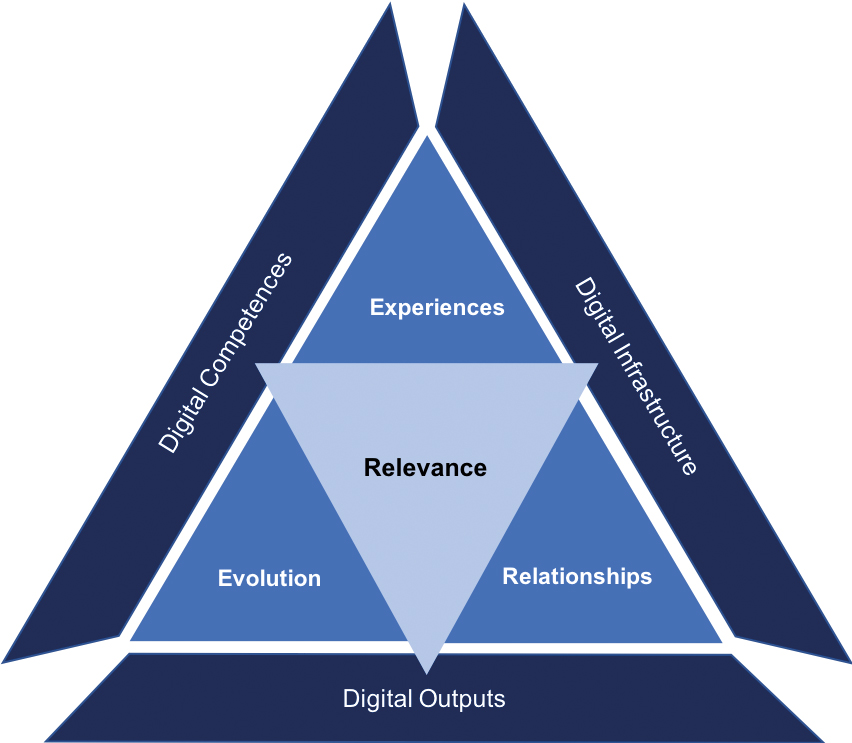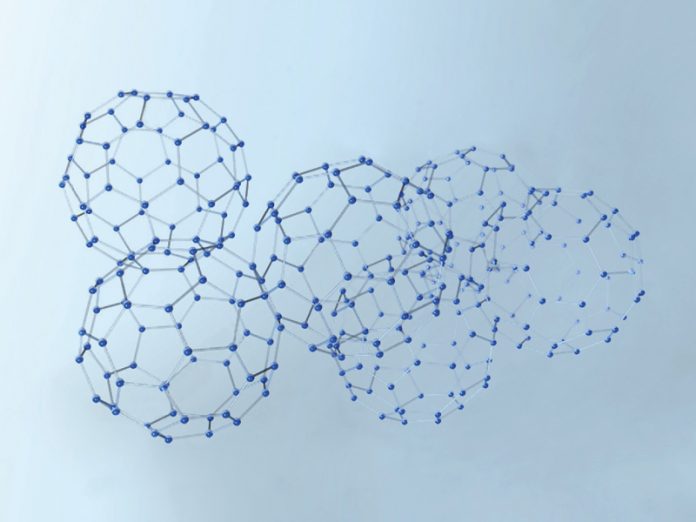By Dr Mike Cooray and Dr Rikke Duus
In this article, we present the Digital Value Creation (DVC) framework. The DVC framework can be used as an evaluative method for organisations to create, enhance and consolidate digital value. We propose that organisations focus their digital value creation efforts in three interconnected areas: creating and managing ‘Experiences’, building meaningful and personalised ‘Relationships’ and accelerating ‘Evolution’ to support business longevity. Organisations must structure their digital value creation efforts within a strengthened outer layer comprising of ‘Digital Competences’, ‘Digital Infrastructure’ and ‘Digital Outputs’. In order to accelerate digital value creation, organisations must be digitally ready and have the internal capabilities and digital set-up that enable it to respond to new and emergent opportunities. At the heart of the DVC framework is ‘Relevance’. The process of digital value creation should be undertaken with Relevance as the interconnecting force between the three DVC elements of Experiences, Relationships and Evolution. Based on our on-going empirical research with organisations that are spearheading digital value creation, we explore the DVC framework through three case organisations: DSB, Coop Denmark and Moleskine.

Experiences
Experiences an organisation creates are central to how customers evaluate the organisation’s ability to meet their needs and expectations1. Customers evaluate their experiences both on how they engage them on an ‘emotive’ level (e.g. how does this experience make me feel?) as well as how the experiences meet certain ‘utilitarian’ needs (e.g. is this experience solving my problem?). It is moreover useful to categorise experiences into those that are ‘set’ (i.e. expected by customers) and those that are ‘situational’ (i.e. arises suddenly and unexpectedly). Many organisations design specific customer experiences which can be marketed to their target audience and broader peripheral groups. Much effort is then made to ensure that the set experiences are optimised, providing certainty and retention of customers. The set experiences are typically measured and monitored with investment made to ensure consistency across delivery points. The organisation has a certain amount of control over these experiences, contrary to those that are situational. Here experiences are unexpected and often deviate from what has been promised to customers, i.e. the set experience. This could be unforeseen delays or a sudden breakdown of a company’s ecommerce site. These situational circumstances influence customers’ experiences and it is at this point organisations’ responsiveness is put to the test. Adverse experiences like these tend to have a wild-fire-effect through the freedom of digital media channels, becoming unruly and with potentially devastating consequences2. Importantly, the situational experiences evaporate considerable investment otherwise made towards optimising the set experiences.
As a way of creating enhanced customer experiences, many organisations use customer journey mapping methodologies to break down the end-to-end journey experience. This methodology highlights which points of interaction add to the experience and which detract. Importantly, customer journeys need to be reviewed on an on-going basis to respond to emerging customer needs and requirements3, including the creation of multi-track journeys to deliver more personalised and segmented customer journey experiences. Increasingly, we see that customers want organisations to use digital technologies and platforms to empower them to make better decisions to manage their set and situational experiences.
Experiences: DSB Digital Labs
The Danish State Railways, DSB, is a large incumbent organisation making greater efforts to enhance customers’ journey experiences. Like many state-owned railways, DSB has its share of challenges relating to train delays, cancellations and poorly perceived customer service. In 2016, as a radical move towards digitalisation, DSB took the first steps to set up a digital innovation hub, called DSB Digital Labs. Clarissa Eva Leon spearheaded this initiative with the overarching purpose of unleashing DSB’s innovative potential.
During our visit to DSB Digital Labs, Clarissa reflected on the journey to date:
In the last three years, we have come a long way in using digital technologies at DSB Digital Labs, not only, to digitise customers’ journey experiences, but also to look at ways in which we can reduce specific painpoints. DSB Digital Labs is now a key partner in driving DSB’s strategic initiatives and continues to focus on enhancing customer experiences and integrating trains with other modes of transport across Denmark.
DSB serves the citizens of Denmark and has a significant responsibility to ensure reliable travel infrastructure and information. However, one of the significant painpoints for the provision of train travel is track repairs and maintenance work. Therefore, DSB Traffic Information and Digital Labs went into action to find a new way to minimise the negative customer experience incurred when replacement bus services are put in place during track repairs and maintenance. Customer dissatisfaction mainly arises from lack of clarity on which bus to take, where it stops, the time it departs/arrives and which connecting trains can be taken for their onward journey.
To find a solution to this challenge, the Digital Labs team looked to the deployment of a chatbot, which, in real-time, could answer customers’ questions and give them the information they need. Using agile innovation methods that led to multiple prototypes, the chatbot “Togbus Tony” (Trainbus Tony) was launched and showed promising results. Based on this early success, the team worked on a chatbot MVP that became “Togbus Frederik” (Trainbus Frederik), which was tested on a selected train route with major train maintenance and use of replacement busses in the summer of 2018. The “Trainbus Frederik” chatbot has proven highly successful, reducing customer dissatisfaction and enhancing the overall travel experience. Based on this success, DSB is putting the chatbot “Togbus Guiden” (the Trainbus Guide) into action from March to November 2020 in five key locations across Denmark. Importantly, DSB will link this chatbot feature to dsb.dk and Rejseplanen.dk (national online travel planner), which connect trains, busses, carpooling, bike hire and car sharing (e.g. DriveNow and GoCarShare), delivering relevant digital value to customers.
In the case of incumbent organisations such as DSB, the Trainbus Guide is a proactive digital initiative that can retain previously built digital value. Such initiatives act as a flood barrier when passengers face situational experiences due to cancellations, track maintenance and other unexpected changes to their journey.
Relationships
At the core of any relationship between an organisation and a customer is trust. However, trust in organisations is on a decreasing scale. There are many sources of this growing distrust, including organisations’ lack of protection of consumer data (e.g. British Airways, Sony, Marriott and Virgin Media) and their adoption of dishonest business practices4 (e.g. Volkswagen, Facebook and Barclays). With increased scrutiny of organisational practices, those organisations that give more control to customers to define their relationship and the level of interaction stand to benefit.
Importantly, relationships require multi-partner agreement, constant reaffirmation and clarity of interdependent reliance, especially in high-volatility market sectors. As in our own relationships, there will always be an initiator of the relationship, typically either the organisation (i.e. organisation-driven) or the customer (i.e. customer-led affiliation). Relationships between organisations and customers are now typically built and managed through digital channels5, which can facilitate a more personalised relationship if customers are given control to influence the extent and nature of the interactions they have with the organisation. Organisations must allow customers to design relevant relationships so that each individual customer can decide what to share with the organisation, which features to use and benefits to gain. Importantly, this individualised approach can help to “declutter” the relationship by surfacing only the information, features and benefits that are deemed relevant to the individual customer at the right moment in time.
Strengthening relationships is ever more important in today’s business environment as brand loyalty is weakened due to increasing market fragmentation and explosion of brand, product and service choice6. Thus, organisations need to review and often re-think how they build better and more value-adding relationships with customers to avoid customer desertion.
Relationships: Coop Denmark
In Denmark we find one of the most holistic and innovative approaches to building and maintaining digital customer relationships within the FMCG food retail and groceries sector. Coop is one of the largest supermarket chains in Denmark and operates brands, such as Kvickly, SuperBrugsen, Dagli’Brugsen, Coop.dk Shopping, Coop.dk MAD, Fakta A/S and Irma A/S. Coop is a cooperative owned by more than 1.8 million members, which makes up approx. 39% of Denmark’s adult population.
In 2016, Coop launched a digital shopping ecosystem delivered through a mobile app to respond to changing customer demands and to enhance its capability to build digital relationships. The app redefines Coop’s relationship with its customers, enabling them to respond swiftly to changing consumption habits and food interests. Importantly, the app creates immediacy and longevity in the way customers engage with Coop.
At its core, the Coop app paves the way to engage with customers in an individualised manner across the 1.8 million members and build digital relationships that ultimately create new value for customers, suppliers and other ecosystem partners. The Coop app ecosystem engages customers through multiple activities, benefits and real-time information. One of the key differentiators is that Coop customers gain a one percent bonus when shopping at Coop and Coop’s partners, which is immediately rewarded in Danish kroner (not loyalty points) and visible within the app to be used for future shopping. This provides a heightened level of transparency and customer gratification, encouraging on-going engagement. To further personalise customers’ relationship with Coop, they receive weekly individualised product offers in the app based on their personal interests, needs and past shopping patterns. This also extends to a feature that gives customers access to superior offers available in their selected local Coop store on a first-come-first-serve basis. This consequently helps Coop to drive local traffic and footfall in their stores.
Today, the app goes much beyond enabling rewards and superior offers. It also helps to remove a significant painpoint within the in-store experience. Customers can use the Scan & Pay solution in the app, which enables them to scan their grocery items, put them directly into their shopping bags and seamlessly pay with the app at the exit. This feature helps to free up time for the individual. Importantly, the app is also designed to be a destination for cooking and meal inspiration. Customers can undertake their food shopping according to specific recipes created by Coop and can select items from across Coop’s supermarket brands, such as Fakta, Kvickly and Irma. This gives customers unique digital access to a wider product range from across the larger Coop supermarket portfolio. Consequently, customers are given the choice to upgrade on some products and choose from a more value-based range for other items. Such digitised provision and empowerment to move freely up and down the value scale induces trust and transparency, which strengthens Coop’s relationship with customers. To further heighten convenience, customers can create shopping lists, access previously bought items and digitised receipts in the app, all contributing to the immediacy and enhanced control of shopping spend. The app also facilitates quick borrowing of up to DKK 1,000 when customers require a short-term injection of funds. Since the launch of the app, Coop’s customer profile has expanded to include younger customers and strengthened the relationship amongst their core customer segments.
During our visit to Coop’s Digital Headquarters in Albertslund, Denmark, Anders Mittag, Senior Vice President, Membership & Loyalty, Digital Channels & Digital Media, professed that:
Coop’s digital journey has been an exciting challenge where we successfully found a way to respond to our customers’ changing needs, enhance their shopping experience and build closer relationships. As an organisation, we have evolved and constantly strive to strengthen our relationships with both Coop members and wider communities as we now have advanced digital capabilities. The Coop app gives us the ability to drive traffic to our stores, strengthen our relationships with both customers and suppliers and continuously try to be relevant to a wide range of customer segments.
For Coop, the launch of their mobile app has acted as a catalyst for an organisation-driven relationship, adding new value to current customers and enthusing others, who may be customers of competitors, to switch to this digital platform. Coop has been able to significantly drive digital relationships with customers by continuously enhancing the necessary digital infrastructure and competences, growing the digital team and focussing intensely on new digital value creation. The enhanced digital competences and data analytics have enabled Coop to expand its membership, strengthen relationships with suppliers, build geographically relevant product portfolios and facilitate the provision of cross-brand portfolio shopping. Coop’s digital infrastructure is now uniquely positioned to provide, not only, horizontal movement across its brand portfolio, but also oxygenate vertical movement, facilitating purchases from value to luxury items. Such consumption flexibility opposes assumptions that consumers remain within a stagnant shopping profile.
While Coop was the initiator of this digital relationship with customers, the relationship is increasingly propelled by customer-led affiliations and desire to engage. This type of engagement is of higher digital value due to being customer-led in nature and an indicator of an ‘earned’ relationship.
Evolution
We live in unprecedented times, where natural disasters, diseases and economic upheaval in one corner of the world can have a detrimental domino effect across markets, regions and nations. In these uncertain environments, possession of superior digital competences and infrastructure can be the difference between collapse and organisational flourish7. Some organisations evolve through a ‘forced’ response when they are under significant pressure to maintain their existence. This kind of response can be uncomfortable for decision-makers and leaders as the actions are driven by external factors with limited internal control. It will also typically require the acquisition of new digital skills and systems. Comparatively, ‘proactive’ evolution is driven by the organisation through a series of strategic moves. These moves accelerate the organisation’s relevance through the use of digital platforms, devices and data.
Through forced and proactive evolution, organisations use digital technologies and channels to evolve the purchase experience, product/service features and the level of customer empowerment and decision-making, leading to enhanced digital value creation. The advanced use of digital technologies can assist to evolve the core product and, at times, extend the original product into a portfolio of affiliated digital services and experiences. This is a sign of an organisation’s ability to adapt to changing customer aspirations and consumption behaviours, while also responding to the impact of the expectancy spillover effect. The spillover effect is an outcome of evolutionary innovations by players such as Amazon, Google and Apple that have wider portfolios of digital products and services.
Evolution: Moleskine
Moleskine is an excellent example of an entrepreneurial organisation that has dramatically evolved its core business model and product offering from a traditional notebook to a digital ecosystem of integrated and interactive physical and digital experiences. Driven by discovery and curiosity, Moleskine is positioned as an exclusive and premium journey brand that enables everyday life on the move. Despite success with the traditional notebooks and time planners, Moleskine has continued to engage in proactive evolution to enable users’ journey along the analogue-digital-analogue continuum. The product portfolio now includes the Moleskine+ range, which is focused on the smart writing system, smart notebooks and apps.
At the core of Moleskine’s evolution is the creation of a digital ecosystem of partners, including Evernote, Adobe and DropBox. These partnerships have been essential to Moleskine’s acceleration into digital spheres by creating connections between customers’ offline experience and their digital creativity. For example, the Adobe Creative Cloud connected Moleskine Paper Tablet allows customers to digitise freehand drawings and sketches in real time when using the Moleskine Pen+. The Moleskine Paper Tablet uses invisible Ncoded technology embedded within each page, which enables the Smart Writing Set Pen+ to recognise where it is within the notebook and to transfer all the freehand notes from page to screen in real time. Moleskine has also developed a suite of apps for mobile and tablets. Moleskine’s iPad app, Flow, received the Apple Design Award and Apple Best iPad App Award in 2019.
These digital innovations illuminate how Moleskine has penetrated through the upper threshold of product enhancement and new product development. At the heart of proactive evolution is an organisation’s ability to go beyond its core product focus and pursue new value through co-creation, working effectively with selected partners. Successful partnerships with Dropbox, Adobe and Evernote have expedited Moleskine’s evolution into digital value creation, enabling them to, not only, respond to the demands of current customers, but also be relevant to new users in a bi-directional way. Here we see how loyal Moleskine notebook users integrate and extend into digital spheres through the new-found connectivity, whilst those who are already using Dropbox, Adobe and Evernote are able to use Moleskine notebooks and Paper Tablets, freeing themselves from digital devices and digitised surfaces. Such bi-directional movement helps organisations to evolve rapidly and ensure their products and services are relevant to wider groups of customers.
In our conversations Peter Hobolt Jensen, Head of Digital Innovation, stated that:
At Moleskine, we are always trying to see how we can do things differently. In the last few years, we have evolved to create value going from analogue to digital to analogue. This, we have achieved by working with great partners, such as Evernote, Adobe and Dropbox. By creating a new digital ecosystem, our customers are able to continue to do what they like, to create, to reflect and build. We have also evolved as a company to go beyond the notebook that we are known for. The digital ecosystem is now complemented with reflective spaces and Moleskine retreats, uniquely positioning us within this shared and creative ecosystem.
Organisations such as Moleskine have achieved an extended life through proactive evolution, stretching its notebook to be positioned as the ideal platform for creativity and reflection, while partnering with digitally-fuelled organisations such as Evernote, Adobe and Dropbox. Such counter-intuitive partnerships create inimitable digital value that extends and boosts Moleskine’s evolution, yet grounding its originality of creativity and reflection.
Digital Value Creation
The DVC framework is an evaluative method for organisations to create, enhance and consolidate digital value. DVC highlights the need for organisations to acquire digital competences on an ongoing basis and invest in ‘stackable’ digital infrastructure that leads to viable digital outputs. This outer layer drives the ability of organisations to enhance set experiences and respond to situational experiences. Organisations that are able to continuously provide freedom of digital infrastructure expansion and create growth funnels to attract cutting-edge competences are able to build organisation-driven relationships and fire up customer-led affiliations. Importantly, in a constantly reshaping digital environment, organisations need to continuously evolve. Organisational evolution can be two-fold: forced or proactive. Forced evolution refers to organisational survival driven by crisis whereas proactive evolution is initiated by organisations through clarity of data, insight into trends and understanding of competitive scenarios, all paving the way to accelerate digital value creation.
About the Authors
 Dr Mike Cooray is a Professor of Practice at Ashridge Executive Education at Hult International Business School. Prior to joining academia he was employed with Carlsberg, Mercedes-Benz and Siemens, working across South East Asia, Europe and the UK. Mike designs and delivers Executive and Masters programmes in the areas of digital transformation, organisational strategy and consumer behaviour.
Dr Mike Cooray is a Professor of Practice at Ashridge Executive Education at Hult International Business School. Prior to joining academia he was employed with Carlsberg, Mercedes-Benz and Siemens, working across South East Asia, Europe and the UK. Mike designs and delivers Executive and Masters programmes in the areas of digital transformation, organisational strategy and consumer behaviour.
 Dr Rikke Duus is senior faculty at University College London, School of Management, and visiting faculty at ETH Zurich. Rikke’s area of expertise is in digital transformation, dynamic organisations and human-tech relationships. She frequently presents at international conferences and events and is widely published in leading global media outlets.
Dr Rikke Duus is senior faculty at University College London, School of Management, and visiting faculty at ETH Zurich. Rikke’s area of expertise is in digital transformation, dynamic organisations and human-tech relationships. She frequently presents at international conferences and events and is widely published in leading global media outlets.
References
1. Pine, B., & Gilmore, J. (2014). A leader’s guide to innovation in the experience economy. Strategy & Leadership, 42(1), 24-29.
2. Etter, M., Ravasi, D., & Colleoni, E. (2019). Social Media and the Formation of Organizational Reputation. Academy of Management Review, 41(1), 28-52.
3. Vakulenko, Y., Shams, P., Hellstrom, D., & Hjort, K. (2019). Service innovation in e-commerce last mile delivery: Mapping the e-customer journey. Journal of Business Research, 101, 461-468.
4. Winston, A. (2015). What VW Didn’t Understand about Trust. Harvard Business Review, Sept.
5. Steinhoff, L., Arli, D., Weaven, S., & Kozlenkova, I. (2018). Online relationship marketing. Journal of the Academy of Marketing Science, 47, 369-393.
6. Nielsen (2019). Battle of the Brands: Consumer disloyalty is sweeping the globe. July. Online: https://www.nielsen.com/us/en/insights/article/2019/battle-of-the-brands-consumer-disloyalty-is-sweeping-the-globe/
7. Crittenden, A.B., Crittenden, V.L., & Crittenden, W.F. (2019). The digitalization triumvirate: How incumbents survive. Business Horizons, 62, 259-266.




































